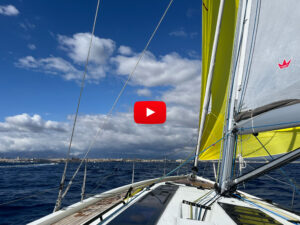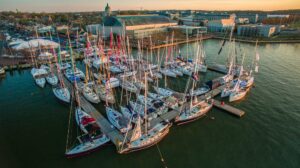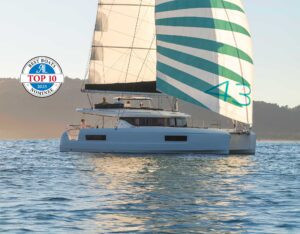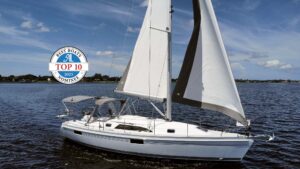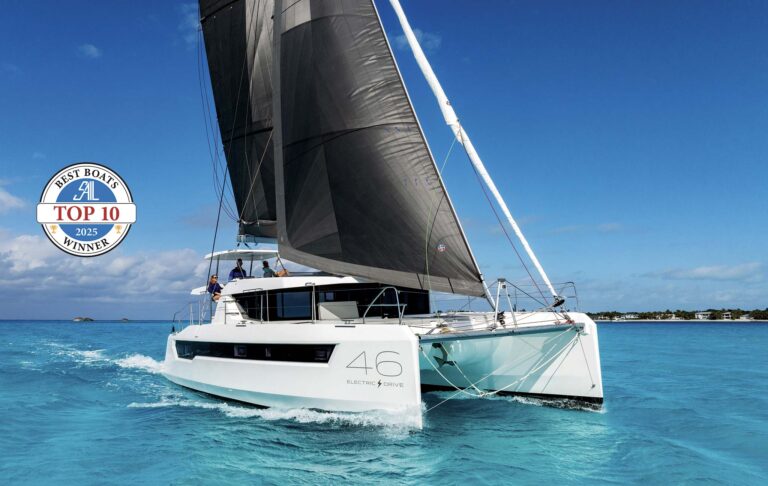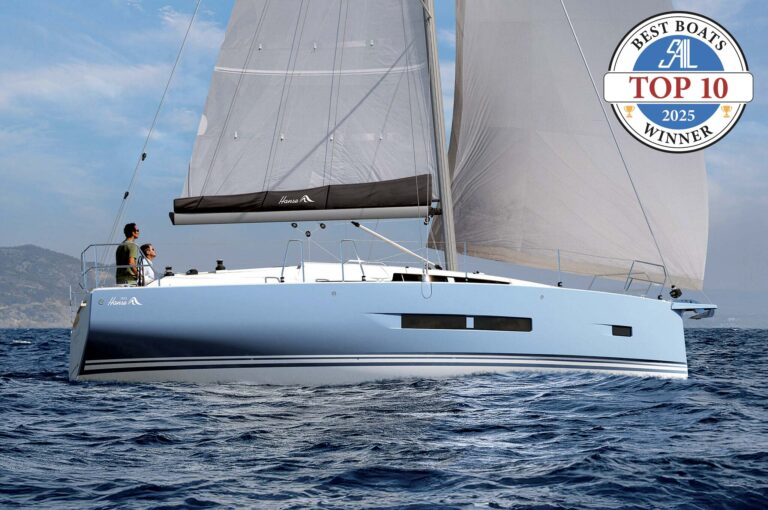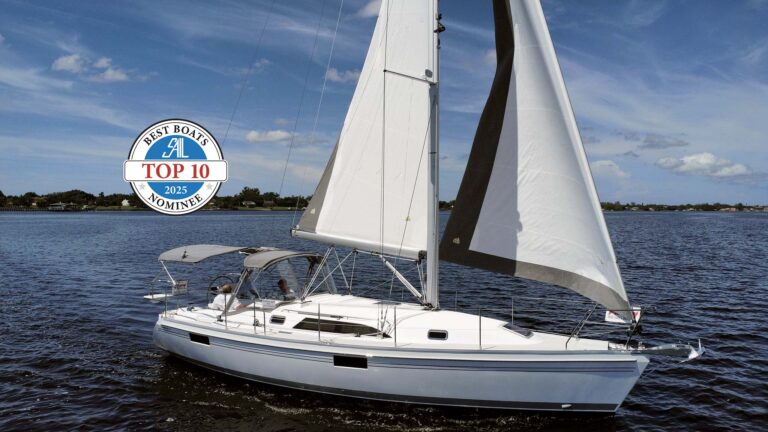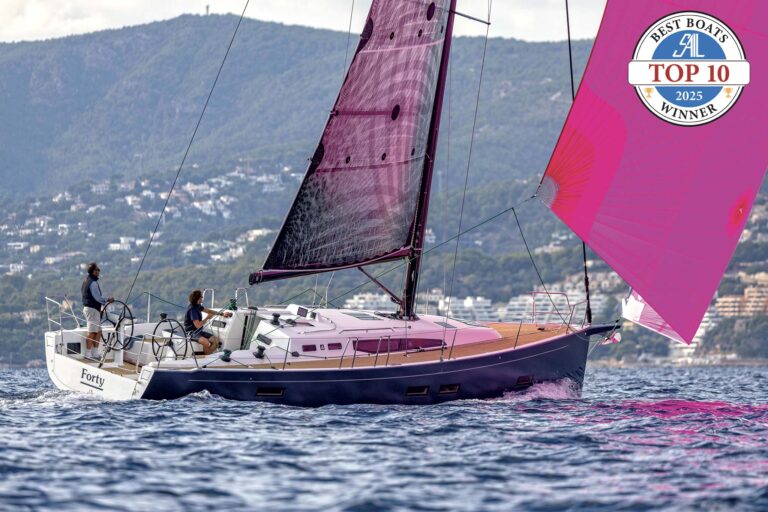
Europe’s Adriatic coastline is not only one of the world’s most attractive cruising grounds, it’s home to some good boatbuilders, too. The latest of these to turn its attention to the U.S. market is Croatia’s Salona Yachts. A relatively young company—its first boats were launched in 2002—Salona aims its boats squarely at the performance cruising market, which was then dominated by X-Yachts and Beneteau’s First line in Europe, and J/Boats in the States. Now that niche is stacked with fine boats, which makes it all the more difficult for any one of them to stand out above the rest. So how does the Salona 44 fare?
Construction
Derived from the company’s former flagship, the Salona 45, the 44’s basic hull form—from J&J Design—is approaching its twelfth birthday, but is not at all outdated. If anything, it reaffirms the fact that you don’t need twin rudders and hull chines and narrow-chord torpedo keels to make a boat go fast and handle sweetly. The 45 was quick, but the 44 has been further enlivened through the use of build practices like resin infusion, which makes it half a ton lighter than its predecessor. The 45’s now-unfashionable scoop transom is gone, and the deck and cabintop have been restyled for a sharp contemporary look.
Salona’s build process is a little out of the ordinary. Blister-resistant vinylester resin is infused into triaxial cloth sheathing a PVC foam core above the waterline. The hull is laid up in a split mold because of the inward-turned flange that takes the deck mold. A pair of hefty full-length stringers stiffens the topsides, and forward of the main bulkhead a molded strengthening grid is glassed into the hull floor. Structural bulkheads are laminated to both hull and deck; the latter is glued and through-bolted to the hull flange. What’s really interesting is the massive stainless steel frame laminated into the hull abaft the main bulkhead; the mast is stepped on it, the chainplates attach to it, and the keel is bolted through it. This hull looks about as bulletproof as they come.
If you order the racing version (as in our test boat), its build will be even more impressive. The “ibc” label stands for Injection, Basalt, Carbon—vacuum-injected resin, basalt fiber, composite bulkheads, carbon rig and rudder.
The 44 carries a keel-stepped triple-spreader fractional Seldén rig with a Harken furling drum concealed under the deck. You can choose the 6ft 9in standard cast iron keel or the lead racing keel, which draws a healthy 8ft 4in. The high-aspect balanced spade rudder reaches nearly to the tip of the standard keel.

On Deck
This boat is particularly easy to move around. The side decks are wide, with chainplates set well inboard and genoa sheet tracks hugging the cabintop sides. Keep the spinnaker pole on the mast—as on the test boat—and the decks are completely unobstructed. If you’re one of those sailors who like to go barefoot, you’ll love this boat. Long stainless steel grabrails terminate just short of the mast, and low teak-capped bulwarks provide just enough security for those working the foredeck. There is a deep anchor well housing a Quick electric windlass as well as the furling drum. The single bow roller should be adequate for most anchoring situations. Mooring cleats at bow, stern and amidships are all well sized.
Befitting its dual-purpose role, the 44 has a dual-purpose German mainsheet setup. In cruising mode, the sheet is rigged as a pair of bridles on the cabintop, where it’s out of the crew’s way. In racing mode, when you want end-boom sheeting, it’s led to a full-width traveler that’s recessed into the cockpit sole just ahead of the twin helms. (When not in use, this traveler is concealed by drop-in infills.) In either case, the business ends of the mainsheet disappear under the deck to re-emerge by a pair of dedicated winches near the helms.
There is much to like about the cockpit layout. The wide footwell is bisected by a sturdy drop-leaf table that serves as a handhold and a bracing point while cruising, and can be removed and stowed for racing. With the table out, there’s a straight shot from the companionway to the transom, between the helms and the legs of the split backstay.
The bench seats are long and wide, and the coamings are well angled, if a trifle low for serious long-term comfort. The twin cockpit lockers are necessarily shallow, because of the cabins below, but are still big enough for most cruising essentials. The liferaft stows under the sole abaft the helms. With the full-width helm bench removed (it can be used as a passarelle), the transom is wide open for access. The lack of a drop-down swim platform may be a deal-breaker for cruising-oriented prospective owners, but racers won’t care.
Accommodations
Interior styling is understated, almost plain, with lots of wood offset against white moldings and accents. The teak veneers (options are ash or mahogany) are horizontally aligned, which adds a nice touch of class and somehow makes the saloon seem wider than it is. Light streams in through flush-mounted hatches overhead and ports in the cabintop and hull sides. The dinette will seat six to eight comfortably; its right-angled settee ends let you wedge yourself into the corners, and instead of the fixed table on the test boat you can specify one that drops to form a double berth. As it is, the port settee makes a fine seaberth—the starboard one is too short for adults. Stowage, under and outboard of the settees and in overhead shelves and lockers, is generous.
I was glad to see the galley in its traditional place, to port, so that it’s easy to cook when the boat is hove-to on starboard tack—not that anyone really does that sort of thing any more, but I like adhering to nautical traditions. It’s a well laid-out galley, with a two-burner stove with a sliding cover, a pair of deep sinks, and a place for the cook to brace him/herself at sea. Again, stowage is generous and well arranged, and there is plenty of worktop space. There’s a big top-opening Waeco fridge/freezer and a smaller front-opening fridge.
Opposite the galley, I was gratified to see a generously proportioned nav table, with bulkhead space for instruments and a simple but comprehensive electrical panel. It lacks only a concave seat to be truly functional at sea. I was also pleased to see plenty of handholds spread throughout the saloon, which has 6ft 6in headroom.

The test boat featured the standard three-cabin layout, with a pair of mirror-image cabins aft and a full-width owner’s stateroom forward. The well-appointed ensuite head forward has a separate shower stall, though the crew’s head aft is a tighter fit all round. An alternative layout has a fourth cabin with Pullman berths forward.
Overall, plumbing and electrical systems are of good quality and sensibly installed so that service points are easy to reach. LED lighting is standard inside and out, which should be mandatory on all cruising boats these days.
Under Sail
We set sail on Florida’s Biscayne Bay in a gentle 8-knot breeze that soon increased to 10-12 knots. This proved ample to get the 44 stretching her legs. Hard on the wind she surged along straight as an arrow, the helm perfectly balanced in the flat water, the Raymarine instruments indicating an easy 7-plus knots that increased to 8-plus in the puffs. Downwind, she tracked equally well in the flat water. This very boat was fresh from a successful tilt at three Caribbean regattas—Antigua Sailing Week, the BVI Spring Regatta and the Voiles de St. Barth—where, with U.S. importer Alex Sastre and a crew of veteran Argentine sailors aboard, she notched up a nice string of victories. As her performance ratios indicate, the boat is no slouch; just as importantly, she gets into her groove quickly and stays there.
She tacked through a little over 80 degrees and would have done better if still set up for racing—and this was with the short keel. The down side of having a deck-sweeping genoa as permitted by the recessed furling drum is that you need to skirt the sail after each tack, which gets tiresome for a cruising crew. A shorter-luffed headsail with the tack raised a foot or so on a strop would cure this. Add a higher clew for better visibility underneath, and you’d have a better cruising setup with only a slight performance penalty. The six winches on deck are all Harken Radials, 60s for the genoa sheets and 50s for the mainsheet and halyards. On a boat this powerful I wouldn’t blame prospective owners for ticking the box for the electric primary option.
Under Power
The test boat boasted the optional 75hp Yanmar turbo-diesel, which was overkill. The consensus is that the standard naturally aspirated 54hp engine is plenty adequate. The installation was well soundproofed and had all service points in plain view. Driving the optional three-bladed Gori folding propeller, the big engine moved us along at an easy 8 knots. Handling under power is precise and predictable, just what you’d expect of a nimble modern boat.
Conclusion
Although the importer naturally makes much of this boat’s racing prowess, this should in no way deter cruising sailors. If you’re in search of a ride that combines the sparkle and good looks of a race-winning boat with the good manners and comfort of a well-built cruiser, you could do a lot worse than the Salona 44.
Specifications
LOA 44ft 4in LWL 40ft BEAM 13ft 9in
DRAFT 6ft 8in (std)/8ft 4in (shoal)
DISPLACEMENT (light ship) 19,842lb Ballast (light ship) 19,842lb
SAIL AREA (100% FT) 1,100ft2
FUEL/WATER/WASTE (GAL) 58/84/11
ENGINE 54hp Yanmar diesel
Ballast RATIO 38% SA/D RATIO 23.6 D/L RATIO 138
What do these ratios mean? Visit sailmagazine.com/ratios
DESIGNER J&J Design
BUILDER Salona Yachts, Split, Croatia, salonayachts.com
U.S. Distributor Salona America, 305-504-8714

